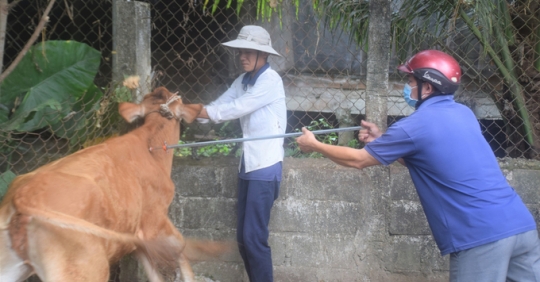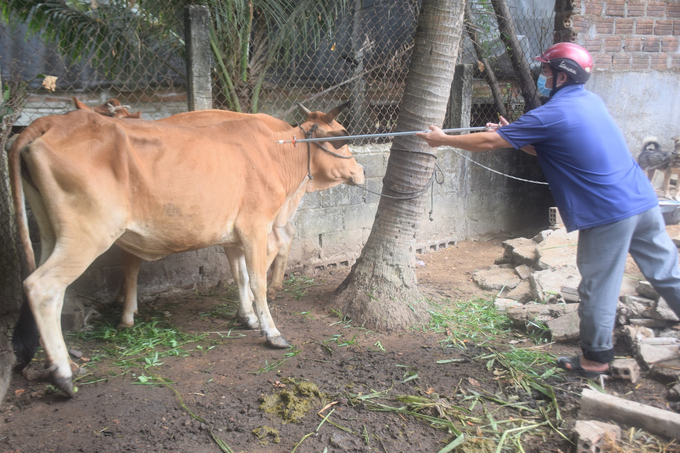
Mr. Le Phuoc Tan, veterinary staff of An Duc township (Hoai An district, Binh Dinh), injects cows in the area with a vaccine against rash. Picture: VDT
Under the intense heat of mid-May, veterinary staff from 15 towns and cities in Hoai An district (Binh Dinh) continued to do their jobs with needles and vaccine containers on motorcycles. In rural areas, livestock and poultry should be vaccinated against diseases.
Mr. Le Phuoc Tan, veterinary officer of An Duc Township (Hoai An District), was taking us to the house of a cow breeder household for vaccination and confided, “This year, at the beginning of the dry season, the heat was intense.” “Sometimes it rains. This weather is a favorable condition for the development of diseases. We need to take care of pet self-vaccination to fight the disease early.”
When we see firsthand the scene where veterinary staff vaccinate cows, we realize the danger of this profession. The horns of cows and buffalo are quite long. If they are not careful when vaccinating, they immediately uproot them. Especially cows get frightened and kick when the needle pierces them, which is very dangerous.
When the veterinary staff comes close to inject, the farmer has to tie in order not to endanger the buffalo and cows, so the vaccination rate is very slow. If 5 cows are vaccinated with a conventional syringe, it takes 20-30 minutes. Not many cows can be vaccinated in one day.
Prior to the above shortcomings, Mr. Tan “modified” a 1-meter-long syringe to avoid close contact with buffalo and cows when vaccinating. Mr. Tan’s “Regime” syringe is a thin, square iron syringe, hollow inside, with a large block of zinc inside as a plunger, used to suck and push the vaccine as it is injected. With this device, veterinary staff can keep a meter distance from buffalo and cows when vaccinating, thus avoiding danger.
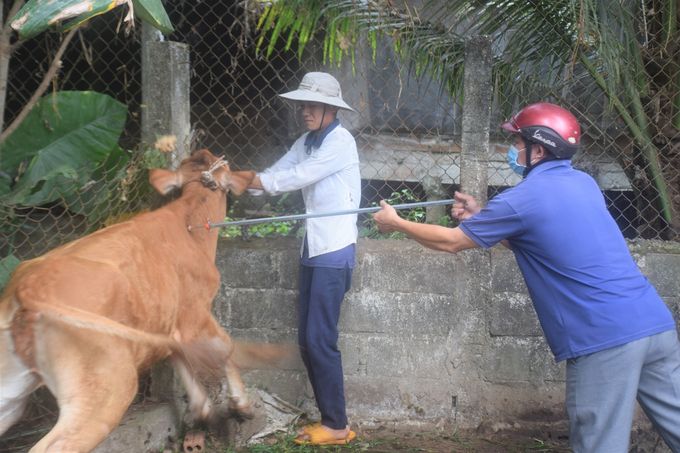
Vaccination of buffalo and cows is very dangerous, so veterinary staff will have to ask breeders for help. Picture: VDT
“Two years ago, since using this ‘regime’ shot every day, I have been able to vaccinate more than 150 buffalo and cows every day. This increases the speed of vaccination, but the owner still spends less effort on keeping buffalo and cows when vaccinating. “The hardest thing about vaccination is that during the rice harvest, people have to let their buffalo and cows graze in the field and wait for them to return to the barn before they can be vaccinated,” Mr Le Phuoc Tan said.
According to Mr. Nguyen Thanh Vuong, director of the Hoai An District Agricultural Service Center, the main driving force behind the work on vaccinating farm animals is the community and village veterinary staff. So far there are 82 village veterinarians in all 82 villages in the Hoai An district, who effectively support the communal veterinarians in the vaccination work.
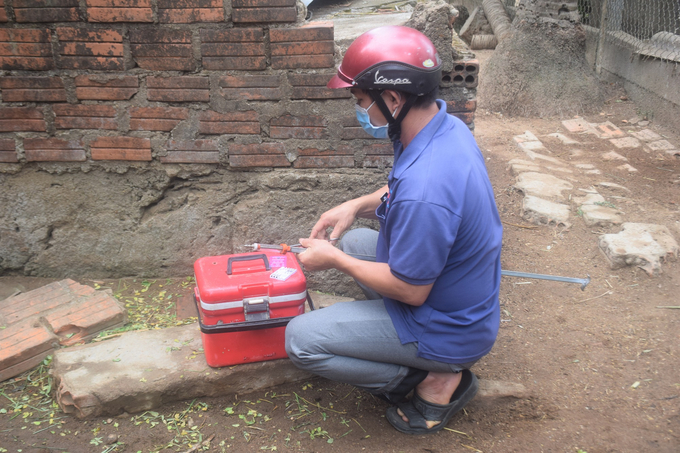
Mr. Le Phuoc Tan, Veterinarian of An Duc Township (Hoai An District, Binh Dinh), is engaged in vaccination work. Picture: VDT
“The most difficult thing about vaccination is in the three mountain communities of Dak Mang, An Son and Bok Toi. People in mountainous areas have a habit of freely raising buffalo and cows, so it is difficult for veterinarians to gain access to vaccines. To accomplish the task, veterinary staff must go to each house to mobilize pastoralists to take cows and buffalo from the mountains for vaccination,” Nguyen Thanh Vuong said.
According to Mr. Vuong, in the past period, thanks to the introduction of local vaccination, livestock in Hoai An district has been safely protected, dangerous diseases no longer threaten livestock and poultry in the country. In particular, in recent years, people’s awareness of the protection of farm animals has been raised, which facilitates vaccination work and thus accelerates progress.
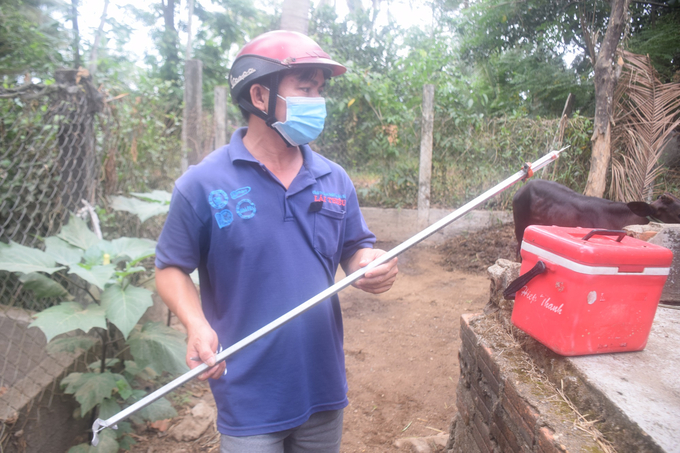
Mr. Le Phuoc Tan, Veterinary Officer of An Duc Township (Hoai An District, Binh Dinh), is helping with a syringe “regime” to keep the vaccination going smoothly. Picture: PHONE
According to Mr. Huynh Cong Chu, head of Vinh Hoa village in An Duc township (Hoai An district), the herd of about 500 cows in the village has been secure in recent years thanks to high vaccination rates. If a rash appeared in buffalo and cows, then in 2-3 month old calves many died. In the last two years, however, this situation has disappeared thanks to state support for a standalone vaccine against cystic dermatitis in buffalo and cows in the region.
At present, Hoai An district has a total herd of nearly 260,000 pigs, more than 27,500 buffalo and cows, and more than 800,000 poultry herds. Compared to ten years ago, Hoai An’s total livestock and poultry population has tripled. To have such a large herd, it is thanks to farmers who are more conscious of vaccination work, so livestock production is developing stably,” said Mr. Nguyen Thanh Vuong, director of Hoai District Agricultural Service Center.

